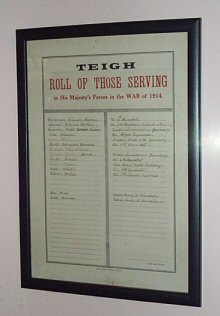
Photo: Keith Shelvey
Teigh
Rutland

Photo: Keith Shelvey
Teigh is a small village of twenty or thirty houses. Holy Trinity Church is to one side of the village and contains the War Memorial, which is of brass on wood. From its inscription, it is clear that this memorial was put in place after the war. The inscription also sets out Teigh's claim to recognition as a Thankful Village, referring to eleven men and two women residents of the village who served in the war and survived.

Photo: Keith Shelvey
However, not far away is a hand-written "Roll of Those Serving in His Majesty's Forces in the War of 1914" a document which was presumably drawn up while the war was still in progress. This document has names but there are twelve men and two women, whereas the memorial plaque mentions eleven men and two women.
It is easy to see who the additional man must be - second in the list is the entry, "William Arthur Haines Private 7th Leicesters Killed in France"

Photo: Keith Shelvey
The fallen man is 14623 Pte. William Arthur Haines who was Killed in Action on 15th July, 1916. Pte. Haines is buried in Dantzig Alley British Cemetery, Mametz, Somme, France. (Soldiers Died in the Great War lists him as member of the 6th Battalion, not the 7th. So does the Commonwealth War Graves Commission, though it names him as Arthur William Haines.) It seems strange that a Thankful Village should have a war memorial giving thanks for the safe return of all its residents, while having a roll of honour which names a soldier who was killed in action. However, the book Rutland in the Great War offers an explanation:
The brass tablet at the east end of the south wall records the fact that all of the eleven men and two women residents of this village who went to the great war returned safely. For this reason Teigh joins a few parishes in being called a "Thankful or Blessed village". The twelfth man,William Haines, was a visitor to Teigh.
Soldiers Died in the Great War states that Pte. Haines was born at Mountsorrel, Leicestershire, but gives no place-of-residence. The book Rutland and the Great War records that he was born at Croft and suggests that he came from Market Overton, He is not named on either of the memorials at these places.
Keith Shelvey, who took the photographs on this page and provided all the material on which this text is based, tells us that there were many ironstone mines in the area and suggests that Pte. Haines may have had some association with Teigh because he was employed at one of the mines, or was known in the village through visits to workmates or friends, drinking in one of the village pubs, or something like that. This could explain what was meant by the phrase "a visitor to Teigh." It seems that the villagers of Teigh, when preparing their Roll of Service during the war, thought fit to include his name, although they appear not to have classed him as a villager when setting up their war memorial plaque afterwards. He may well not have considered himself to be a real member of that community either. The memorial plaque only refer to "residents".
With thanks to Keith Shelvey for his help in preparing this page.